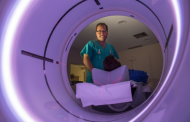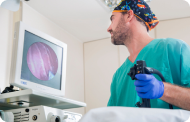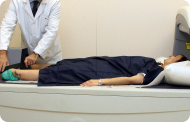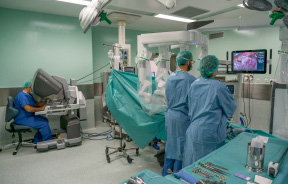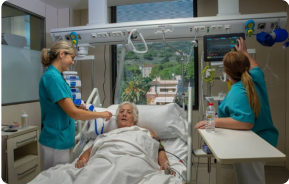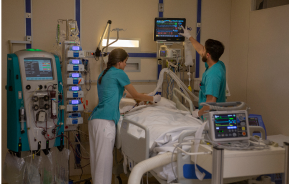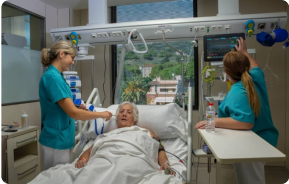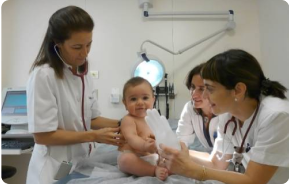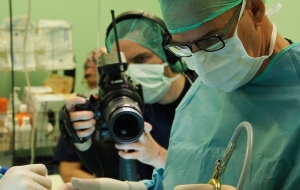

 Ginecología y ObstetriciaCentro Médico Teknon
Ginecología y ObstetriciaCentro Médico Teknon Ginecología y ObstetriciaCentro Médico Teknon
Ginecología y ObstetriciaCentro Médico Teknon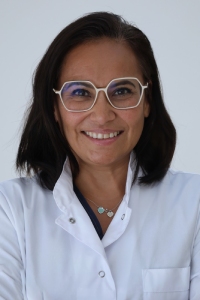 Ginecología y ObstetriciaCentro Médico Teknon
Ginecología y ObstetriciaCentro Médico Teknon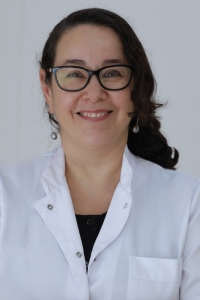 Ginecología y ObstetriciaCentro Médico Teknon
Ginecología y ObstetriciaCentro Médico Teknon Ginecología y ObstetriciaCentro Médico Teknon
Ginecología y ObstetriciaCentro Médico Teknon
¿Qué es la endometriosis?
La endometriosis es un proceso benigno que se caracteriza por la presencia y proliferación del tejido endometrial, que normalmente se halla dentro del útero o en otras zonas distintas fuera de esta misma cavidad.
En Estados Unidos padecen la enfermedad unos 12 millones de mujeres de todas las razas. Esta alteración es una de las más estudiadas e investigadas en todo el mundo, lo que ha dado lugar hasta el momento a unos 4.500 artículos. A pesar de este gran interés académico todavía existen importantes lagunas en el conocimiento de esta enigmática enfermedad.
- ¿Qué tipos hay?
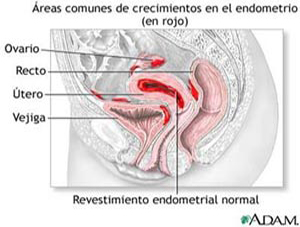 Existen tres tipos distintos de endometriosis identificadas:
Existen tres tipos distintos de endometriosis identificadas:- Una de ellas se desarrolla en los ovarios, dando lugar a quistes que pueden alcanzar tamaños considerables; estos se conocen con el nombre de endometriomas. Dichos quistes contienen un líquido espeso de color marrón oscuro, lo que hace que se les denomine quistes de chocolate. Es la endometriosis ovárica.
- Otro tipo aparece en el tabique recto-vaginal, tejido que se encuentra entre el recto y la vagina. Es una endometriosis profunda y muy activa y recibe el nombre de endometriosis del septum recto-vaginal.
- Una tercera afecta al peritoneo, tejido que recubre los órganos internos. Esta suele adoptar distintas formas; manchas rojizas o marrones, o pequeños quistes de un color azul oscuro. Habitualmente se encuentran en la cara posterior del útero, pero también pueden localizarse en la vejiga urinaria o intestinos. Su principal característica es que puede crear grandes adherencias en diversos órganos. Es conocida como endometriosis peritoneal.
En ocasiones, el tejido endometrial posee una capacidad de crecimiento y diseminación similar a la de los tumores malignos, y por ello se le ha denominado el cáncer benigno.
- ¿Qué causas originan una endometriosis?
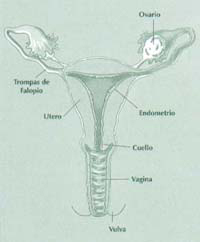 La causa real es todavía desconocida. Sin embargo, la teoría más admitida es la del reflujo de sangre de las menstruaciones hacia la cavidad abdominal y la implantación de las glándulas del endometrio sobre el peritoneo o en los órganos intra-abdominales. Es la denominada menstruación retrógrada, que padecen la mayoría de las mujeres, aunque no en todas desencadena una endometriosis, por lo que parecen existir factores adicionales que alteran el sistema inmunológico u hormonal y permiten que las células endometriales arraiguen y proliferen. Es posible que este reflujo se inicie en la pubertad, aunque no suele dar síntomas hasta más tarde. Las últimas investigaciones apuntan la posibilidad de que ciertas toxinas ambientales, como la dioxina, puedan ser responsables de lo que parece ser una moderna epidemia: la endometriosis.
La causa real es todavía desconocida. Sin embargo, la teoría más admitida es la del reflujo de sangre de las menstruaciones hacia la cavidad abdominal y la implantación de las glándulas del endometrio sobre el peritoneo o en los órganos intra-abdominales. Es la denominada menstruación retrógrada, que padecen la mayoría de las mujeres, aunque no en todas desencadena una endometriosis, por lo que parecen existir factores adicionales que alteran el sistema inmunológico u hormonal y permiten que las células endometriales arraiguen y proliferen. Es posible que este reflujo se inicie en la pubertad, aunque no suele dar síntomas hasta más tarde. Las últimas investigaciones apuntan la posibilidad de que ciertas toxinas ambientales, como la dioxina, puedan ser responsables de lo que parece ser una moderna epidemia: la endometriosis.La localización habitual de las lesiones endometriósicas es en el ovario y ligamento ancho; con menos frecuencia se han observado lesiones digestivas; íleon, apéndice, ciego, en la vejiga urinaria o en el uréter. También puede desarrollarse a partir de restos celulares embrionarios o por una transfusión del epitelio peritoneal.
- Predisposición genética
Entre un 15 y un 20% de las mujeres padecen esta enfermedad. Un dato curioso es que se encuentran lesiones en un 70% de autopsias efectuadas en la menopausia, habiendo pasado desapercibidas durante toda la vida. Se sabe que existen familias con endometriosis. Si una madre o hija la padecen, las posibilidades de que algún otro miembro de la familia desarrolle la enfermedad se incrementa unas siete veces.
- ¿Cuáles son los síntomas?
La endometriosis ha sido en varias ocasiones causa de separaciones matrimoniales y de pérdidas de puestos de trabajo, debido a su naturaleza incapacitante.
El síntoma más frecuente es el dolor, que se caracteriza por una intensidad extremadamente variable sin relación aparente con la localización y extensión del proceso.
Puede presentarse durante las menstruaciones (dismenorrea), durante el coito (dispareunia) o bien en forma de dolores de espalda (lumbo-sacralgias).
También son habituales los dolores pélvicos generalizados con distensión abdominal. El dolor puede presentarse de una forma moderada o bien intensa, modificando el biorritmo; y cuando se trata de una endometriosis del tabique recto-vaginal la práctica del coito puede desencadenar un dolor intenso, causando un impacto emocional negativo que altera la calidad de vida de las mujeres.
En una encuesta realizada a más de 4.000 mujeres afectadas por la enfermedad, casi la mitad revelaron que fueron necesarias 5 consultas ginecológicas o más para llegar al diagnóstico exacto.
 Aunque el dolor es el síntoma más frecuente, algunas mujeres aquejadas por la enfermedad no lo padecen. Grandes superficies de tejidos afectados por endometriosis pueden causar dolores leves. Sin embargo pequeños endometriomas que actúan en profundidad desencadenan importantes molestias. El síndrome de fatiga crónica se asocia también con frecuencia a las enfermas de endometriosis.
Aunque el dolor es el síntoma más frecuente, algunas mujeres aquejadas por la enfermedad no lo padecen. Grandes superficies de tejidos afectados por endometriosis pueden causar dolores leves. Sin embargo pequeños endometriomas que actúan en profundidad desencadenan importantes molestias. El síndrome de fatiga crónica se asocia también con frecuencia a las enfermas de endometriosis.Otro síntoma importante es la esterilidad que afecta a pacientes con esta enfermedad. Se calcula que entre un 30 y un 50% de pacientes con endometriosis presentan esterilidad y muchas de ellas son diagnosticadas tras practicar una laparoscopia.
La endometriosis se asocia frecuentemente con enfermedad poliquística del ovario, miomas uterinos, quistes ováricos y malformaciones genitales congénitas o adquiridas.
- ¿Cómo se diagnostica?
El diagnóstico de la endometriosis viene determinado por la presencia de dolor pélvico, una masa palpable en la pelvis y la esterilidad. Estos datos orientan hacia el diagnóstico de esta enfermedad, mientras que las formas leves en ocasiones pasan desapercibidas y quedan sin diagnosticar. Así pues, el diagnóstico se sospecha por los hallazgos de la historia clínica y la exploración física, confirmándose de una forma precisa efectuando una laparoscopia.
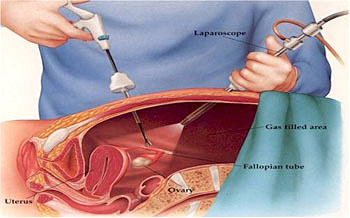 Durante esta intervención quirúrgica, bajo anestesia general, se introduce un fino endoscopio fototransmisor (laparoscopio) a través de una diminuta incisión en el abdomen. El cirujano puede así examinar el estado de los órganos abdominales y verificar la dimensión y magnitud de los tumores endometriales. Este método permite descartar otros problemas que presentan síntomas similares.
Durante esta intervención quirúrgica, bajo anestesia general, se introduce un fino endoscopio fototransmisor (laparoscopio) a través de una diminuta incisión en el abdomen. El cirujano puede así examinar el estado de los órganos abdominales y verificar la dimensión y magnitud de los tumores endometriales. Este método permite descartar otros problemas que presentan síntomas similares.Los adelantos en las técnicas y los instrumentos para la endoscopia permiten a los ginecólogos realizar determinados procedimientos a través del laparoscopio que anteriormente habrían sido efectuados de forma más invasiva.
Uno de los mayores logros en el diagnóstico ha sido precisamente la incorporación de las microcámaras a los laparoscopios y la visión a través de los monitores de alta resolución.
Otras técnicas como la ecografía, el escáner o la resonancia magnética pueden valorar la presencia de lesiones endometriósicas en localizaciones distantes, sin embargo, solamente la laparoscopia ha permitido el diagnóstico más temprano de la enfermedad de mujeres en edad fértil.
El hecho de que casi el 50 % de adolescentes con dolor pélvico severo sean tributarias de presentar endometriosis, sugiere la realización de laparoscopias para el tratamiento precoz de la enfermedad. Las investigaciones realizadas en los últimos años han demostrado que la percepción que se tenía de que la endometriosis es una enfermedad que afecta a mujeres de raza blanca, sin hijos y mayores de 30 años, es errónea.
- Laparoscopia diagnóstica
La laparoscopia diagnóstica para descartar una endometriosis está indicada en los siguientes casos:
- Mujer estéril en fase de estudio
- Esterilidad de origen desconocido
- Cuando hay hallazgos anormales en la exploración de las trompas: "histerosalpingografía"
- Pacientes con dolor pélvico
- Anomalías en el examen pélvico




